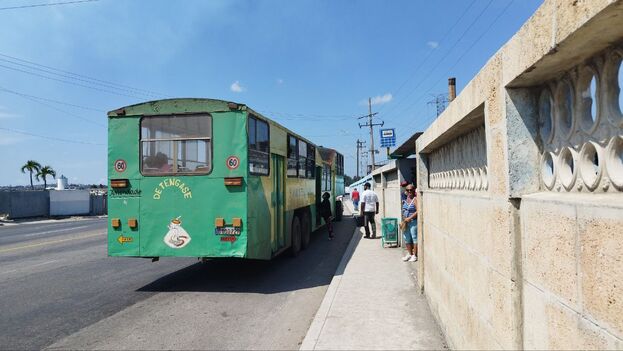
![]() 14ymedio, Juan Diego Rodríguez, Havana, 28 April 2023 — Last Wednesday, a 14ymedio reporter sent a photo that he had just captured on Avenida del Puerto, in Havana: a camello [camel] was picking up passengers on a route that took them to La Palma, a neighborhood on the periphery. It was further proof that the fuel shortage was creating a transport crisis similar to the one experienced in the 90s, during the Special Period, which began even before the end of the Soviet subsidy.
14ymedio, Juan Diego Rodríguez, Havana, 28 April 2023 — Last Wednesday, a 14ymedio reporter sent a photo that he had just captured on Avenida del Puerto, in Havana: a camello [camel] was picking up passengers on a route that took them to La Palma, a neighborhood on the periphery. It was further proof that the fuel shortage was creating a transport crisis similar to the one experienced in the 90s, during the Special Period, which began even before the end of the Soviet subsidy.
In 1988, the Cuban engineer Jorge Hernández Fonseca and his colleagues from the National Office of Industrial Design proposed to the authorities an idea to end the transport crisis in Havana. The vehicle, locally manufactured, would have the capacity to carry more than 300 people on each trip. A few years later, the “invention” had become the symbol of an entire time of survival, and there was no bus stop at which its arrival was not expected, often in desperation.
“The idea was for the Island to have a kind of ’metro’ on the streets,” says 14ymedio reporter Hernández Fonseca, exiled in Miami. The “inventor of the camel” describes as “cyclical” the collapse of public transport in the capital and in the main cities of the Island since the triumph of the Revolution. The return of the “metrobus” that never was, constructed from two or three buses assembled with a trailer on an 18-wheeled chassis with two “humps” in the ceiling, is no surprise.
“I think it is the most sensible thing to quickly alleviate the crisis,” says the engineer, although he doubts that the country is in a position to manufacture new buses with the characteristics that the camels had. Those that circulated during the Special Period were made by “the cargo transport companies and the Army.” In addition, he says, it had the ability to save fuel due to the large number of passengers it could pick up on a single trip.
Hernández Fonseca, who has traveled through several capitals of the world, understood that in the Cuba of the 90s, after the fall of the Soviet Union, there was no way to sustain an underground subway network. A bus with certain characteristics of the subway was the only option. “Everyone who has used a subway knows that mass transport is prioritized over comfort. We must remember the context in which the first metrobuses arose: the Special Period.”
The fuel crisis that the Island is now experiencing, he reflects, is a “repetition” of that time. Many Cubans, however, thought they had exceeded the time when camels were the only option to get to the work center or move around the city. Today, the few buses that circulare in Havana — “leased” according to their signs — bring with them the bad taste of the economic debacle of the 90s.
Criticism of the ’camel’ is not only aimed at the bad memories it brings to most Cubans by associating it with the crisis but also at how hot it is inside, given the many passengers it transports and its small windows. The shocks it causes in the homes located on the avenues where it circulates also adds to its defects.
“Cubans have more criticisms than compliments about the camello,” recognizes Hernández Fonseca, who claims to be no stranger to the discomfort of the vehicle, but it must be understood that “there was no other alternative” at that time, he says. As the situation is, he does not consider it a thing of the past nor does he see it as part of a future Cuban transport museum.
Translated by Regina Anavy
____________
COLLABORATE WITH OUR WORK: The 14ymedio team is committed to practicing serious journalism that reflects Cuba’s reality in all its depth. Thank you for joining us on this long journey. We invite you to continue supporting us by becoming a member of 14ymedio now. Together we can continue transforming journalism in Cuba.
